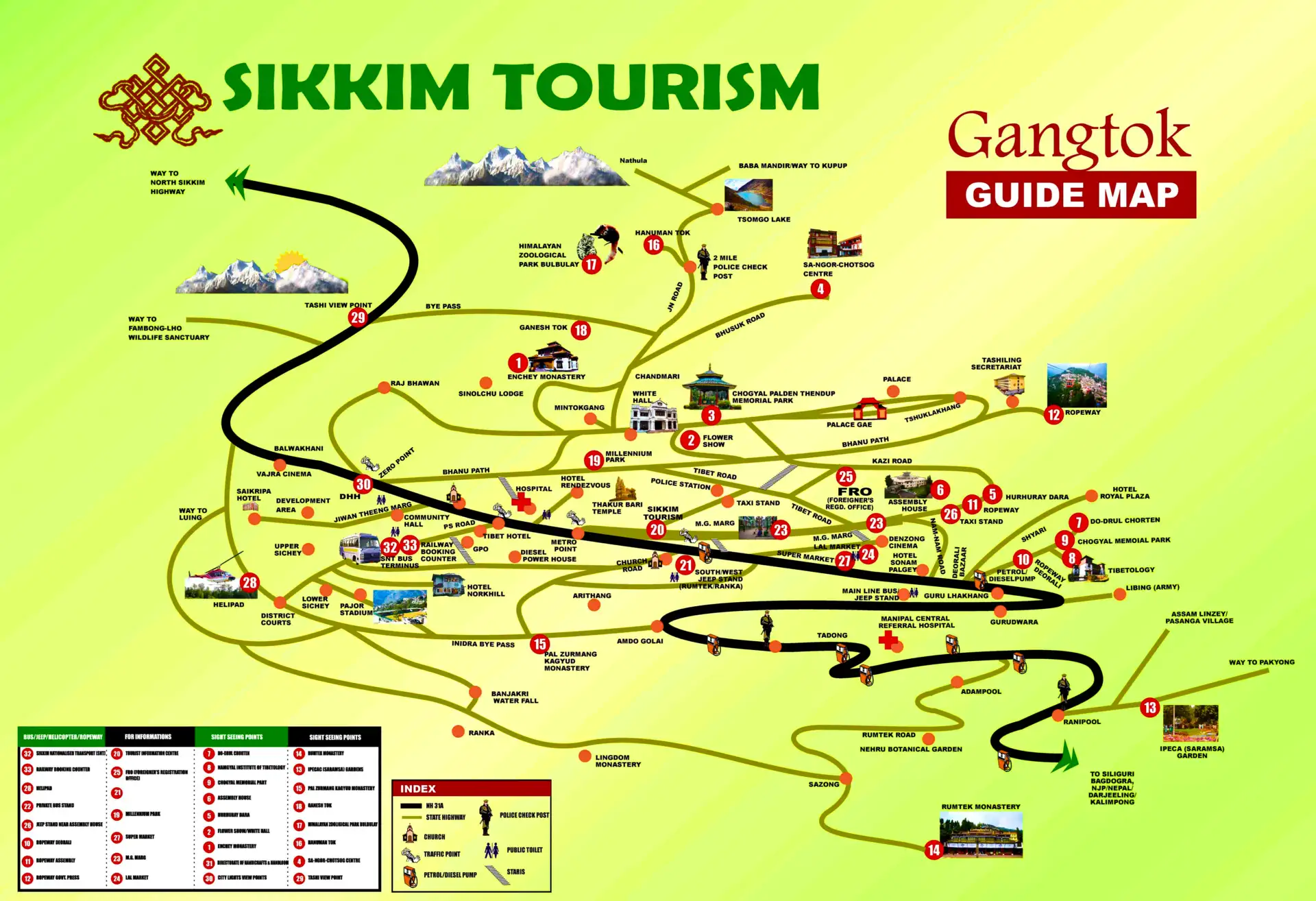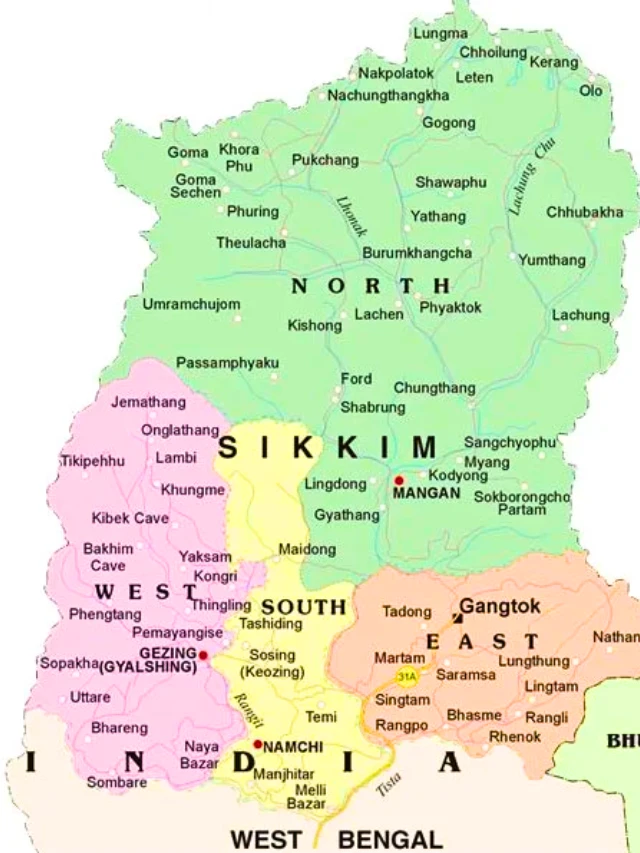Travelers may enjoy a wide variety of activities in Sikkim, a tiny state in northeastern India, from snow capped mountains to lively cultural attractions. This state is well liked by those who value spirituality, adventure, and the natural world since it is hidden away in the Himalayas.
This is a guide to some of Sikkim’s top tourist attractions, If you want to avoid the hassle of booking tickets, arranging transportation, finding hotels, handling documentation, and dealing with paperwork, visit our Sikkim Tour Packages page. Explore the best packages for Sikkim and Darjeeling, and make your trip truly memorable!
Exploring the Geography and Size of Sikkim
Sikkim is one of the smallest states in India, but it’s full of interesting with places, people, and stories. Located in the eastern part of the Himalayas, it has a mix of high mountains, green valleys, and quiet villages.
What makes Sikkim even more special is where it is on the map. It shares its western border with Nepal. On the north and east sides, it touches China, specifically the Tibet region. Bhutan is just to the southeast, and West Bengal, another Indian state, lies to the south.
Because of its location, Sikkim is influenced by many cultures. You can see this in the food, language, and festivals celebrated here. It’s also a popular place for people who love nature, with lots of mountain views, rivers, and walking trails. Even though it’s not very big in size, Sikkim has a lot to offer and is easy to spot on the map once you know where to look.
Sikkim covers an area of around 7,300 square kilometers, which makes it one of the smaller states in India. Even though it’s not very big, the land is very different in different places. From north to south, Sikkim is about 114 kilometers long, and from east to west, it’s about 64 kilometers wide.
One of the most interesting things about Sikkim is how high and low the land goes. Some areas are just 300 meters above sea level, while others reach over 8,500 meters, including some of the highest mountains in the world.
One of the most famous parts of Sikkim is Mount Kanchenjunga, which is the third highest mountain in the world. It stands at 8,534 meters and is easy to spot on the map. People in Sikkim respect this mountain a lot and see it as a guardian or protector. If you look at the shape of Sikkim, it’s kind of like a thumb. Even though the state is small, it’s full of different cultures and amazing views, with mountains, forests, and peaceful places all around.
Administrative Structure of Sikkim
Sikkim is divided into four districts, and each one is managed by a district collector. The district collector is a person chosen by the Central Government to handle the administration and make sure everything runs smoothly in their area.
The Four Districts
- East Sikkim
- District Capital: Gangtok
- Subdivisions: Pakyong, Rongli
- West Sikkim
- District Capital: Geyzing
- Subdivision: Soreng
- North Sikkim
- District Capital: Mangan
- Subdivision: Chungthang
- South Sikkim
- District Capital: Namchi
- Subdivision: Ravongla
Sikkim holds strategic importance because it borders countries like China, Nepal, and Bhutan. As a result, several areas fall under the Indian Army’s control, and visitors need special permits to enter those regions.
Additional Administrative Details
Sikkim has eight towns and nine subdivisions, which helps manage the state more smoothly. This setup allows local areas to be run well while also supporting the state’s important location near international borders. Some parts of Sikkim are restricted because they’re close to these borders, but the way the state is organized helps balance daily governance with national security needs.
Key Features of Sikkim’s Economy
Sikkim’s economy relies on a few key factors that make it unique in the region :
- Agriculture: The fertile land in Sikkim is perfect for farming, and agriculture plays a huge role in the local community. Many different crops are grown here, which not only meet the needs of the people living in Sikkim but also help with exports.
- Tourism: Tourism is a key part of Sikkim’s economy. The state’s stunning natural beauty, with its tall mountains and peaceful scenery, draws visitors from all over the world. This helps local businesses grow and creates more job opportunities.
- Strategic Location: Sikkim has a unique advantage because it’s the only place where India and China share a border that can be accessed. This makes it a key spot for trade and cultural exchanges, which helps boost Sikkim’s economy.
The combination of these elements makes Sikkim’s economy resilient and dynamic, fostering growth and innovation.
Gangtok: The Capital City
The capital of Sikkim, Gangtok, is a place you just must see. This vibrant city provides a unique combination of contemporary conveniences and old world charm. In the center of the city, along the MG Marg, tourists may stroll, buy for regional goods, and sample some of the mouthwatering food.
One of the most important monasteries in Sikkim, the Rumtek Monastery lies close to Gangtok and is renowned for both its beautiful architecture and spiritual importance.
Situated around 40 kilometers outside of the city, Tsomgo Lake is a further highlight of Gangtok. Surrounded by mountains, this glacial lake is especially well-liked in the winter when it freezes over.
The Namgyal Institute of Tibetology provides an in depth look at the background and customs of Tibetan Buddhism for individuals who are interested in experiencing local culture.
Nathula Pass: A Gateway to History
At 4,310 meters above sea level, Nathula Pass is a significant historical monument. It is now used as a border station between China and India and was a component of the historic Silk Route.
A special permission is needed to visit Nathula, but the trip is worthwhile. In addition to providing beautiful views of the surrounding mountains, the pass gives a chance to learn about the region’s geopolitical importance.
Pelling: The Scenic Town
A little village in West Sikkim called Pelling has become well known for its breathtaking vistas of the Kanchenjunga mountain range. Given that it is the beginning point of several trekking routes, it is a perfect location for those who like hiking.
This is the location of the Pemayangtse Monastery, one of Sikkim’s most significant and ancient monasteries. The old sculptures and paintings of the monastery are well known.
The Rabdentse Ruins, the ruins of the old capital of the Kingdom of Sikkim, are another point of interest close to Pelling. The ruins provide a window into the past of the area and are easy to access from the main road.
Yuksom: The Historic Capital
Yuksom, the little town that served as Sikkim’s first capital, is very important historically. In 1642, Sikkim’s first Chogyal, or king, was crowned here. The settlement serves as the beginning point for the well known Dzongri and Goecha La treks and is encircled by thick trees.
The Norbugang Coronation Throne, a stone throne where the first monarch was crowned, is also located in Yuksom. This location is serene and ideal for anyone who want to think back on the rich past of the area.
Lachung and Lachen: The Twin Gems of North Sikkim
North Sikkim’s Lachung and Lachen villages provide as entry points to some of the most breathtaking natural locations in the area. Yumthang Valley, or the Valley of Flowers, is the reason Lachung is well known. This valley is a wonderful area to explore in the spring and is home to a variety of alpine flowers.
The trek to one of the world’s highest lakes, Gurudongmar Lake, begins at Lachen, which is a few hours’ drive from Lachung. The lake is a breathtakingly beautiful natural location that is revered by both Buddhists and Hindus.
Zuluk: The Serpentine Road
Zuluk, a little village on the Old Silk Road, is well known for its striking scenery. The settlement of Zuluk is situated on a hill, and getting there requires traveling down narrow roads that provide expansive views of the surrounding mountains. For a great view of the Kanchenjunga range, go to the Thambi Viewpoint, which is close to Zuluk.
Ravangla: The Place of Buddha Statue
Situated halfway between Pelling and Gangtok lies the little settlement of Ravangla. The Buddha Park, a sizable statue of the Buddha that attracts tourists from all over the globe, is located there. The park provides a serene setting that is perfect for introspection and meditation. The village is an excellent starting point for visiting neighboring monasteries, including Tashiding Monastery and Ralang Monastery.
Where Are the Sikkim Tourism Information Centers Located?
Discover the convenient locations of Sikkim Tourism Information Centers across key cities:
- Gangtok: Located at Mahatma Gandhi Marg, this center is at the heart of Sikkim’s capital, providing easy access for locals and visitors alike.
- New Delhi: Situated at New Sikkim House on 14, Panchsheel Marg, Chanakyapuri, the center offers comprehensive assistance for travelers planning to explore Sikkim from the capital city.
- Siliguri: You can find a hub of tourist information at the SNT Colony on Hill Cart Road, making it a significant stop for those traveling by road to Sikkim.
- Bagdogra: For those flying in, there’s a conveniently located center at Bagdogra Airport, ensuring tourists can gather all necessary travel insights right after landing.
- Kolkata: Located at 4C Poonam Building, 5/2 Russell Street, the center in Kolkata caters to visitors from the bustling metro area looking to journey to Sikkim.
These centers are strategically placed to facilitate seamless travel planning for Sikkim explorers.
What Permits Are Required for Foreign Nationals to Visit Sikkim?
Navigating the permit requirements for foreign nationals aiming to explore Sikkim can seem daunting, but with the right information, it’s straightforward. Here’s a concise guide to help you plan your travel:
Restricted Area Permits (RAP)
Foreign nationals need to secure a Restricted Area Permit (RAP) to visit even those regions in Sikkim that are open to Indian citizens without special permissions. These permits allow access to key areas and must be arranged ahead of your visit.
Where to Obtain Permits
Permits can be acquired from a variety of authorized locations, such as:
- Indian embassies and missions worldwide.
- Foreigners Regional Registration Offices (FRRO) in key Indian cities including Delhi, Mumbai, Kolkata, and the Chennai Tourist Office.
- Immigration authorities at airports in major Indian cities.
- Government offices in Sikkim like the Chief Secretary, the Home Secretary, and the Inspector General of Police in Gangtok.
- Tourism offices and resident commissioners located in New Delhi, Kolkata, Siliguri, and Darjeeling.
Permitted Areas and Duration
Once you have your RAP, several popular destinations in Sikkim become accessible:
- Gangtok, Rumtek, Phodong, and Pemayangtse: You are allowed to visit these locations for up to 15 days.
- Trekking in Zongri (West Sikkim): Permits are available for groups of four or more, organized through recognized Indian travel agencies.
- Changu Lake and Yumthang Valley: Visits are permitted for groups of four or more travelers.
Special Routes and Guidance
For trekking, specific routes are approved. For the Zongri trek, options include:
- Pemayangtse – Yoksum – Zongri
- Rangpo – Gangtok – Yoksum – Zongri
Each group will have an assigned liaison officer provided by the Sikkim government to ensure compliance and safety.
Additional Permits
If you want to visit certain areas in Sikkim, you’ll need a special permit from the Ministry of Home Affairs in New Delhi. It can be a little tricky to get, but local travel agents can help you with the process.
By following the rules and planning ahead, visitors can easily enjoy the beauty and culture of Sikkim.
The Ideal Time to Explore Sikkim
Sikkim is a place full of stunning views and rich culture. While it’s a great destination all year round, the best times to visit are from March to June, when the weather is just right, and from September to December, when the skies are clear and the landscapes are at their best.
March to June: Spring Blossoms & Mild Weather
- Weather: As spring unfolds, temperatures are pleasantly mild, ranging from 5°C to 25°C.
- Flora and Fauna: This is the perfect time to witness rhododendrons and orchids in full bloom.
- Activities: Enjoy trekking adventures and visit picturesque lakes and monasteries.
September to December: Post Monsoon Serenity & Festivals
- Weather: As monsoon rains recede, clear skies reveal stunning views of snow capped peaks, with temperatures hovering between 4°C to 18°C.
- Cultural Insights: The post monsoon season coincides with vibrant festivals like Dashain and Tihar, offering a deep dive into local traditions.
- Outdoor Fun: Trekking routes are open, and the crisp air enhances the experience of exploring Sikkim’s serene landscapes.
Sikkim offers something special in every season, making it a year round destination for travelers. However, to truly experience the best of this Himalayan gem, plan your visit during the months of March to June or September to December.
From March to June, the weather is pleasant, with clear skies and mild temperatures, perfect for exploring the state’s natural beauty and cultural sites. September to December brings crisp air and stunning mountain views, ideal for trekking and sightseeing.
Each of these periods offers unique and memorable experiences, ensuring that Sikkim is a great place for all types of travelers. With an open mind and a sense of adventure, these seasons provide the perfect setting to discover everything Sikkim has to offer.
What is the Predominant Religion in Sikkim?
The predominant religions in Sikkim are Hinduism and Vajrayana Buddhism. These spiritual traditions deeply influence the cultural fabric of this Indian state.
Hinduism
- Widely practiced across Sikkim, Hinduism is a significant part of daily life and traditions.
- It features a diverse array of rituals, festivals, and temples that draw visitors and locals alike.
Vajrayana Buddhism
- A strong presence in Sikkim, this branch of Tibetan Buddhism is central to many of the state’s monastic practices.
- Numerous monasteries dot the region, serving as key spiritual and cultural landmarks.
Both religions co exist harmoniously, contributing to Sikkim’s rich cultural tapestry.
Conclusion
Sikkim has something for every type of traveler. Whether you’re into adventure, history, culture, or simply relaxing in nature, there’s a spot for you. From the lively streets of Gangtok to the peaceful environment of Zuluk, every corner of Sikkim invites you to explore and discover its unique charm.


